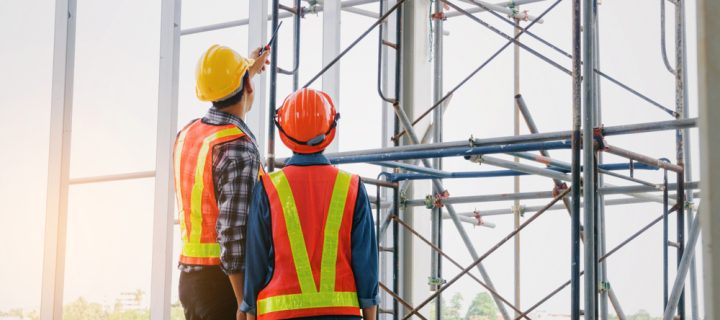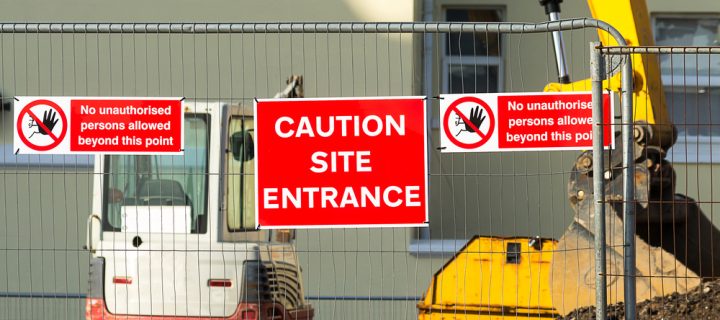Scaffolding provides a safe and stable platform for construction, maintenance and repair work. However, what many individuals might not realise is that scaffold towers and systems have specific weight limits which must be complied with. As a scaffolding company, we believe it’s critical to understand these scaffold weight limits when working on any construction project, whether you work as a scaffolder or a construction project manager. In this article, we will explain the maximum scaffold weight limits, the influencing factors and the risks of exceeding them. Understanding Scaffold Weight Limits Scaffold weight limits refer to the maximum amount of weight a scaffold system can safely support without compromising its stability. These limits are vital to ensuring the safety of workers as well as the successful completion of the construction project. According to the Health and Safety Executive, weight limits for general access scaffolding can be divided into four main categories: Very light-duty scaffolding can support loads up to 0.75 kN/m² Light-duty scaffolding can support loads up to 1.50 kN/m² Medium-duty scaffolding can support loads up to 2.00 kN/m² Heavy-duty scaffolding can support loads up to 3.00 kN/m² Factors While the above weight limits are only a guideline for access scaffolding, there are a number of factors which can influence scaffold weight limits. These include: Scaffold Type – Different scaffold systems are capable of supporting different load capacity. For instance, shoring scaffolding is designed to support heavier loads than access scaffolding. Materials and Equipment – The weight of materials and equipment placed on the scaffold must be within recommended limits. Number of Workers – The number of workers on the scaffold system can affect the overall weight limit. Local Regulations – Adhering to local regulations and building codes is non-negotiable. They often take into account factors such as climate, seismic activity and other site-specific conditions. These regulations may differ for scaffolding in your area. Scaffold Condition – Regular inspections are vital to ensure the scaffold system remains in good condition. Damaged or weakened parts can significantly reduce the scaffold’s weight-bearing capacity. To determine the maximum weight limit for your scaffold system, you will need to consider these factors and calculate the added maximum weight on your scaffold system at any...
Read Moreabout What Are Scaffold Weight Limits?When your building is under construction, the premises can be put in a vulnerable position. Therefore, one of the important things is keeping your site as secure as possible. If a site is not secured properly, members of the public or children can gain unauthorised access and risk an injury occurring from falling objects or attempting to climb your scaffolding structure. Another reason you need to keep your site closed off is to prevent vandalism and damage being caused to your site. For those reasons, it is crucial to prevent unauthorised access at all times, not only during the day but also outside of working hours, as these incidents could happen at any time. This may lead you to ask the following question: how do I prevent unauthorised access to my site? Here are 3 effective ways to achieve this. 1) Access Control Implementing access control measures can add an extra layer of security including locked gates or key-coded entry systems. By restricting access to only authorised personnel such as construction workers, you can prevent unauthorised individuals from entering your site. This provides a basic level of security. However, locked gates can be vandalised or climbed over, thus giving unauthorised access so you will need to add additional safety measures to increase the level of security. 2) Carry Out Regular Inspections Regular inspections and monitoring help to detect any signs of unauthorised access and trespassing. This can involve assigning someone or hiring security staff to regularly check the site and scaffolding for any unusual activity. By promptly identifying and addressing any potential breaches, you can ensure the safety and security of your site. Alternatively, installing CCTV cameras around your site can provide you with 24-hour surveillance. With modern technology, the latest CCTV systems allow you to view real time surveillance of your site from a remote computer, tablet or mobile phone. 3) Plastic Hoarding Secure the site by setting up some form of physical barrier around the scaffolding area. These can be sturdy fencing, barricades or plastic hoarding. Plastic hoarding refers to the use of plastic sheets or panels to create a temporary barrier or enclosure. It is commonly used on building and construction sites to separate the work...
Read Moreabout 3 Ways To Prevent Unauthorised Access To Your SiteNot only are Network Scaffold Services able to erect scaffolding quickly and efficiently, but we can also ensure your demolition and building sites are kept safe and secure. As well as our scaffolding services, we also provide the installation of high-quality plastic hoarding. There are many ways our hoarding service can protect your demolition and building site, so, we thought it would be a good idea to educate you on some of those ways our hoarding can help. 1) Provides Site Security The Health and Safety Construction (Design and Management) Regulations 2015 states all contractors must take the necessary steps to prevent unauthorised entry to their building sites. A secure barrier around the site and the installation of adequate hoarding before any construction work begins can prevent the risk of trespassers entering and vandalising the property. 2) Keeps The Project Hidden Installing hoarding will help keep the project hidden and under wraps until it’s ready for the grand reveal to the public. This allows the site to seamlessly blend into the surrounding area, especially in large cities such as London and Manchester. With hoarding, the project can’t be exposed until it is time for the project to be unveiled. This limits outside pressures and intrusive opinions, enabling the work to be carried out as constructed. As plastic hoardings are a temporary measure, they can be easily removed once the project is complete. 3) Protects The Public From Hazards The number of children killed or injured on building sites has reduced in recent times. However, the HSE has said every year, two or three children are killed from unauthorised access to building sites, and many more children are injured. Hoarding will provide protection to the general public from any potential injury. With hoarding, there is a physical barrier between the public and building equipment, on-site vehicles, falling objects, materials, and any other hazards. Plastic Hoarding From Network Scaffold Services Once the hoarding is installed, it will be verified by our team to withstand the wind and any other potential strain which may be put on it. Regular checks will be performed by our expert team to ensure it remains stable throughout the project’s development. On completion, Network Scaffold Services can...
Read Moreabout How Our Hoarding Can Protect Your Demolition And Building SitesThough it might not feel too long ago, we have not spoken to you about the many benefits of plastic hoarding since late March. Back then we were completely unaware of the many major events that would take place over the summer. A summer that saw the UK reach record high temperatures as well as countless other record breaking events taking place. In our previous blog regarding plastic hoarding, we touched on how plastic hoarding is frequently used at large scale events such as music festivals and concerts. As you might have guessed, these events are typically held during the summer period. Now that the summer period is almost over, you might be forgiven for thinking that there is little to no need for plastic hoarding, however, this is not the case. At Network Scaffolding, we don’t just supply high quality scaffolding in Derby, we also install and supply plastic hoarding too. Because of this, we have decided to detail reasons why you should still use plastic hoarding this September. Adherence To Health and Safety Regulations When it comes to construction, events and the overall wellbeing of employees and the general public, health and safety is of paramount importance. Plastic hoarding is a key element in regards to ensuring health and safety proceedings are upheld. Plastic hoarding has more benefits than simply deterring potential intruders, it is quite essential in the protection of your employees and the general public at large. In addition, you can rest assured that plastic hoarding service is carried out in accordance, just like other services offered at Network Scaffold, with the best health and safety regulation standards in mind. Cost Effective Hoarding panels are found to be an incredibly cost effective security solution. Plastic hoarding systems are extremely effective at securing the site meaning there is less need for extra expenditure for other security measures. Furthermore; the boards can commonly be used more than once meaning you are not required to fork out on additional panels. This clearly highlights that hoarding systems are particularly good value for money. Securing The Site No matter the site that is being serviced, be it office buildings, hospitals or, perhaps more importantly, construction sites, the site being safe...
Read Moreabout Using Plastic Hoarding This SeptemberRecently Network Scaffold Services has expanded its range of products, including plastic hoarding and safety decking for construction projects. Our hoarding is designed for strength, durability, and simplicity which makes it quick and easy to erect, adapt and dismantle. It is also possible to promote your corporate identity on the boards, plus they can be reused for another project in the future. Sustainability benefits Fully reusable and recycle Zero waste to landfill Reduces the carbon footprint of your project 100% recyclable at end of life Commercial and Construction benefits Installation service or training available from our team of installers Quick and easy to erect, adapt and dismantle External and internal applications Where can I use plastic hoarding? Here are some examples of how plastic hoarding can be utilised across different sites – Internal or external shop frontage Ideal for festivals and events needing temporary fencing Hoarding scaffolds and structures Construction and demolition projects Also, suitable for offices, soundproof areas, and hospital sterile areas Why is hoarding so important? Construction sites that use hoarding will keep intruders out plus they will ensure the safety of the general public passing by. The Health and Safety at Work etc Act 1974 and the Construction (Design and Management) Regulations 2015, which were introduced by the HSE’s Construction division state the importance of having secure hoarding around construction sites. Unlike timber construction panels, our plastic panels are water-resistant, which means they do not rot and can be reused; saving you money on standard plywood products. Get in touch for more information If you would like more information about Network Scaffold’s range of plastic hoarding, please do not hesitate to contact us today. Our team of specialists will be more than happy to answer any queries you may have. Don’t forget Network Scaffold also supplies signature scaffolding products such as edge protection, alloy towers plus access scaffold...
Read Moreabout What are the advantages of plastic hoarding?One of the questions we receive from clients looking for plastic hoarding is; do I need planning permission for it? According to the Town and Country Planning (Control of Advertisements) Regulations 2007, advertising on a hoarding wall qualifies as what is known as ‘deemed consent.’ Advertisements that are classified as deemed consent does not require planning permission from the local planning authority as long as they comply with particular criteria. For this blog, Network Scaffold will explain construction hoarding and permissions that could be required in greater detail. What is the Criteria of Consent for Construction Hoarding? For advertising on site hoarding to qualify for deemed consent, it will need to meet the following conditions – No advertising is displayed earlier than three months before building operations start. The local planning authority has been notified of the day when the advertisement will be first displayed, at least 14 days before the first display date. The person proposing to display the advertisement needs to notify the local planning authority in writing and send a copy of the relevant planning permission. No advertisement is more than 38 square metres in area No part of the advertisement is more than 4.6 metres above ground level The advertisement won’t be displayed for more than 3 years However, if you need plastic hoarding for construction work in a conservation area, an Area of Outstanding Natural Beauty, a National Park, the Broads or an area of special control, advertising hoardings are not permitted. Final Considerations for Plastic Hoarding Any graphics placed on hoarding walls will only benefit from deemed consent if they are placed on construction sites. Advertisements on hoardings for residential sites will always require consent. Talk to the Specialists Today If you are looking for the finest plastic hoarding on the market, get in touch with Network Scaffold Services today. We are the leading supplier for customers across Derby, Nottingham and the surrounding...
Read Moreabout Do I Need Planning Permission for Plastic Hoarding?



